高考英语快满分,去考托福,会得几分?
今天来和大家聊一个话题:咱们的高考英语,相当于什么样的水平?
比起高考语文,尤其是高考作文,大家对高考英文的关注度,好像低不少。为什么,说来很多人不相信。因为,对在走“原版路线”的孩子们,高考英语,实在算不上难啊~
听起来很“凡尔赛”,但这方面的真实例子,咱们每年都能看到不少。比如,最近几年高考结束后,不少花友带着“玩一玩”的心态让自家孩子做做高考英语卷,结果“喜出望外”,体制内中小学最高级别英语考试,不少10岁上下的“原版娃”,就能自如应付!
11岁娃“高考英语卷”自测近乎满分
“小学毕业前娃搞定了英语, 到中高考都不发愁了”
在这儿坚持打卡2年, 7岁女儿高考卷准确率90%
这么小的孩子,真的可以如此轻松Hold住英语么?是孩子太牛,还是考试太容易?
回答这个问题前,先问大家一个问题:
你认为一个高中毕业生,学了12+年英语,英语达到了什么水平?
怎么衡量,一个可以参考的标准是大家熟悉的托福考试。
大家知道,孩子要去美国读书,必须要参考托福考试,这个考试主要测一个英语非母语的高中毕业生能否在美国的大学用英语听懂、读懂、表达、交流学术内容。
什么意思?就是可以顺利用英语学习知识,世界前沿知识。
我们会想,无论去不去留学,这就是孩子们辛辛苦苦学了12+年英语,要达到的基本目标啊!
如果这是一个令人向往的目标,那么高考英语,大概处于什么水准?大家和新航道常州托福培训机构老师一起来看看。
1
首先,词汇量
学英语、英语考试,大家第一想到的就是词汇量这个“硬性指标”。高考英语VS托福,词汇量相差多少?
高考英语的数据好找,在《普通高中英语课程标准》词汇表的说明里就有。
3500个!这就是高考试题的词汇范围。
规定很明确,包括小学、初中、高中三个阶段,一共是3000个单词,另外建议酌情增加200个单词。考虑到这3000词中基本不含派生词,所以再加上常用派生词,达到3500词就足够了。
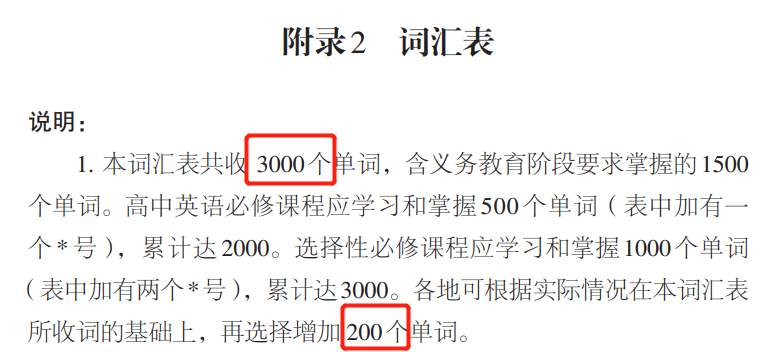
2017年版高中英语课程标准词汇量
也就是说,想要在高考英语里考到140+分以上,甚至接近满分150分,应该掌握的词汇量标准大概是3500词。(作为参考,研究生入学考试英语考试大纲要求的词汇量是5500个;而专门为英语专业学生而设的英语等级考试专八要求的词汇是8000个左右…)
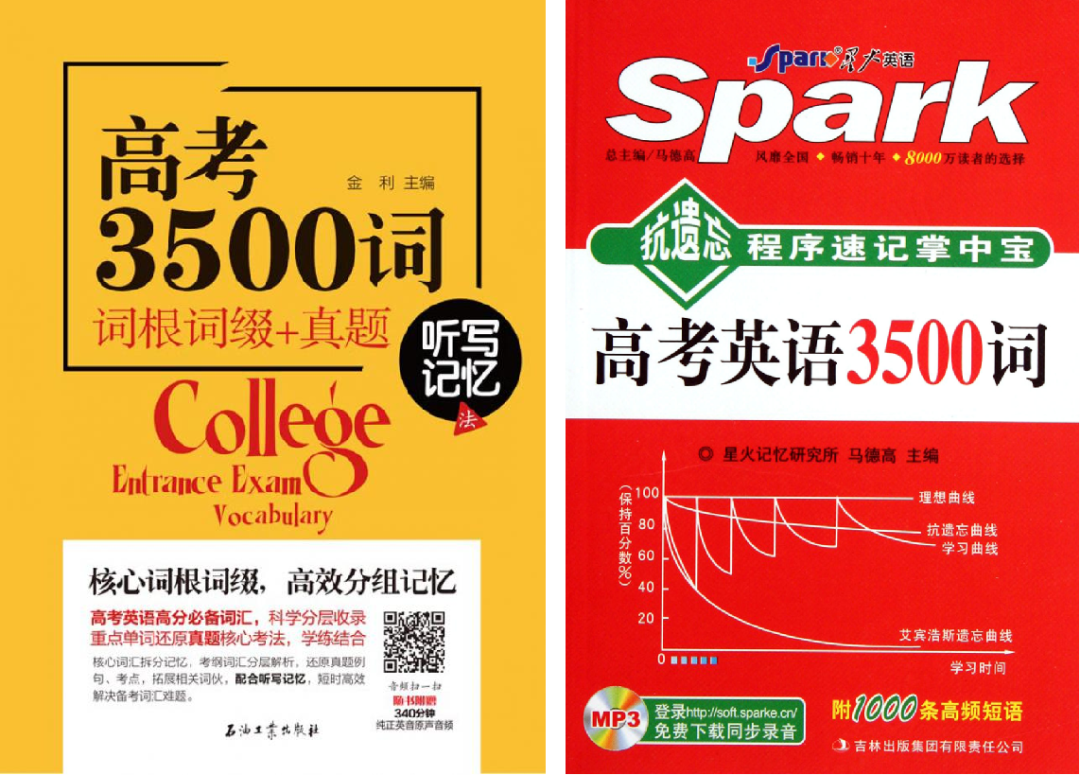
托福是一个学术英语语言测试,主要考察在学术语言任务环境下的真实学术语言能力;简单来说,就是考察学生是否能够听懂大学里用全英语讲授的课程。
托福考试满分是120分,一般来说,90分以上就已经不错了,100分以上可以去美国名校了,110分以上已经达到了全世界多数学校的标准。
没有官方的词汇表,不过通常都认为词汇量要求在8000-10000左右,是高考英语词汇量的2-3倍。
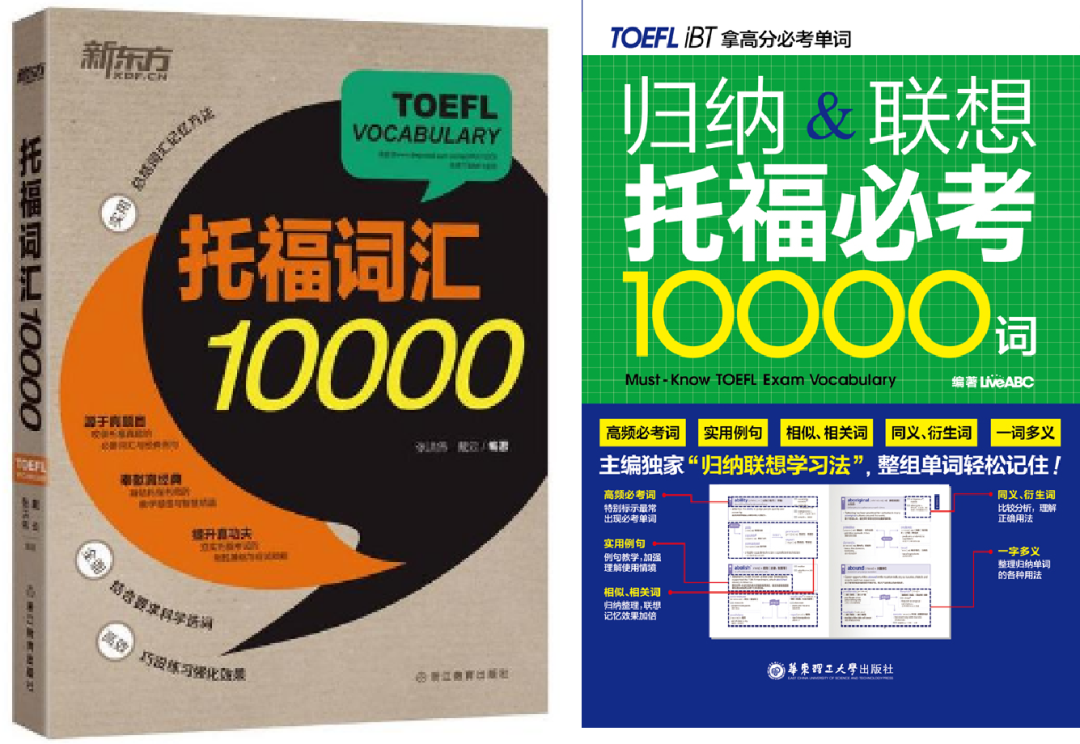
经研究,词汇量和托福考试成绩之间有“强相关”关系,大概是这样:
词汇量为9000的考生,托福考试成绩大多集中在90-100分;
词汇量为8000-7000的考生,成绩大多集中在80-90分;
词汇量为6000的考生,成绩大多集中在70-80 分之间;
词汇量为5000及以下的考生,成绩大多集中在60-70分。
以高考词汇量作为标准,一个高考英语考到140分的学生(3500词汇量),参加托福考试能得多少分呢?
应该低于60-70分,那么究竟是几分呢?这个,仅仅看词汇量,就不够了。
2
参照能力等级去PK
还好,有靠谱的官方资料。
2018年,教育部和国家语言文字工作委员会发布了《中国英语能力等级量表》,将英语能力从低到高划分为基础、提高和熟练,共三个阶段、九个等级。
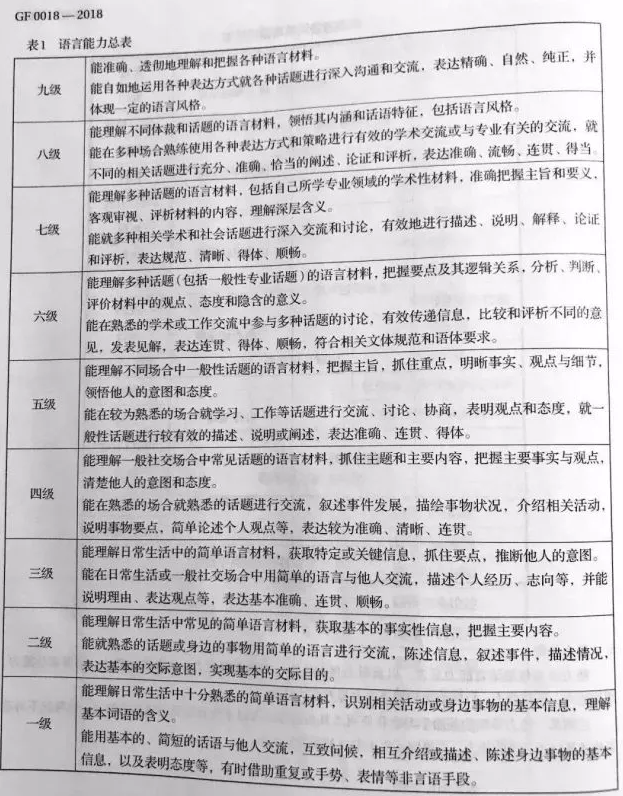
根据这个标准,国内的学生在高中毕业时,达到了第4级别,即:
能理解一般社交场合中常见话题的语言材料,抓住主题和主要内容,把握主要事实与观点,清楚他人的意图和态度。
能在熟悉的场合就熟悉的话题进行交流,叙述事件发展、描绘事物状况,介绍相关活动,说明事物要点,简单论述个人观点等,表达较为准确、清晰、连贯。
也就是能基本理解别人在说什么,能对话,能表达自己的想法。
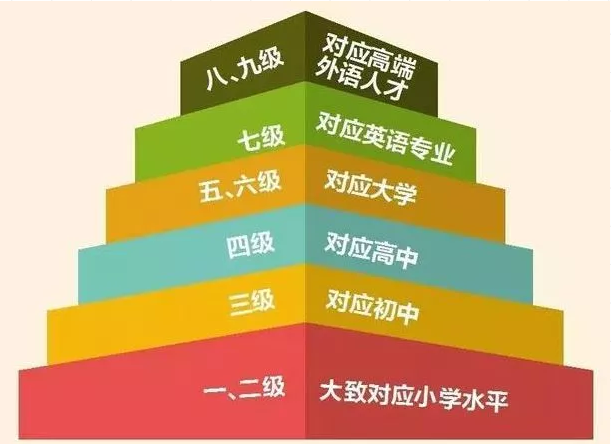
好几种国际考试都和咱这能力量表做过对接。能力四级,相当于欧标A2-B1级(有英语基础了,中级起步),和剑桥PET考试水平差不多,也是托福、雅思考试的下限。

还有更精确的对照。托福的举办方ETS表示,中国英语能力等级量表的4级到8级分别对应托福考试总成绩的37分到101分。
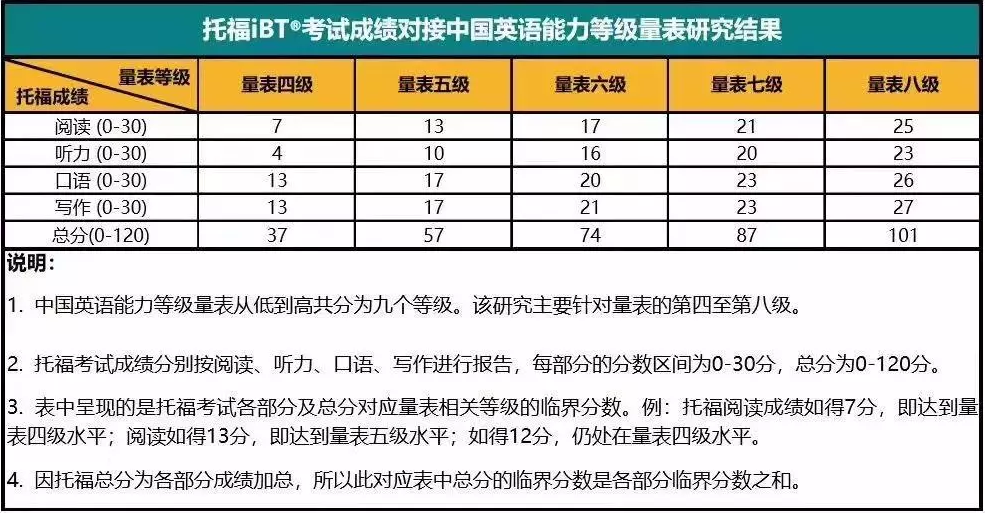
也就是说,咱们的高考英语满分150分,相当于托福考试40分左右!
参照托福考试的百分位,40分对应的百分位只有3(也就是说,97%的人考的比你好!)

换句话说,如果托福考了40分,只是超过了全球3%的考生。看来,一路跟着校内英语学了12年后,咱们大部分孩子的英语能力还只是处于起步水平。
3
听说读写,全面对比
提到英语能力,一般说的是听力、阅读、口语、写作四个方面的综合能力。
高考英语不太侧重对口语、听力的考察。
比如,口语考试是要另行安排时间进行的,通常是报考外语专业的学生参加,而且不计入总分,只用作“参考”。
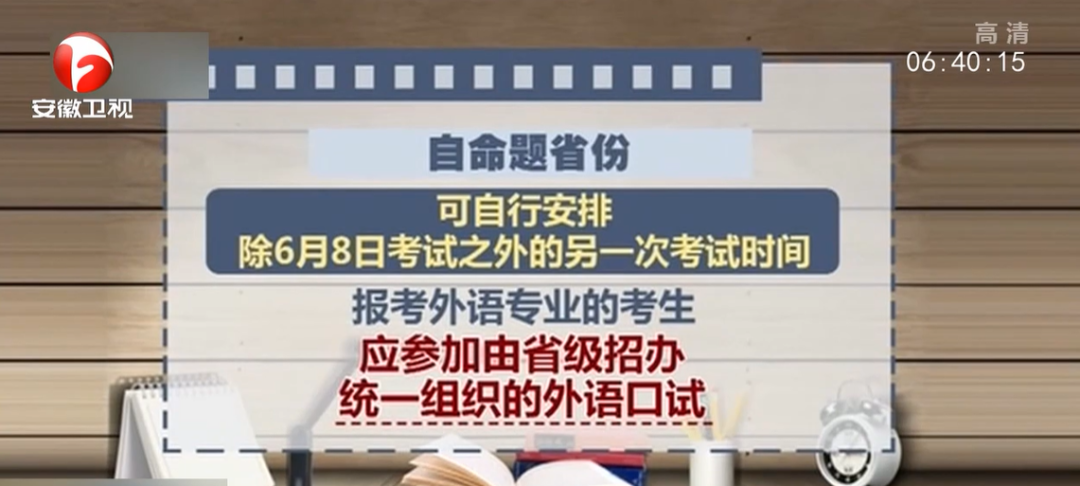
此外,部分省份不考听力;有的省份虽然考听力,且占比30分,但不计入总分,英语笔试的120分会折合成150分。
从题量和分值上可以看出,重点考察的是阅读理解、语法和写作:
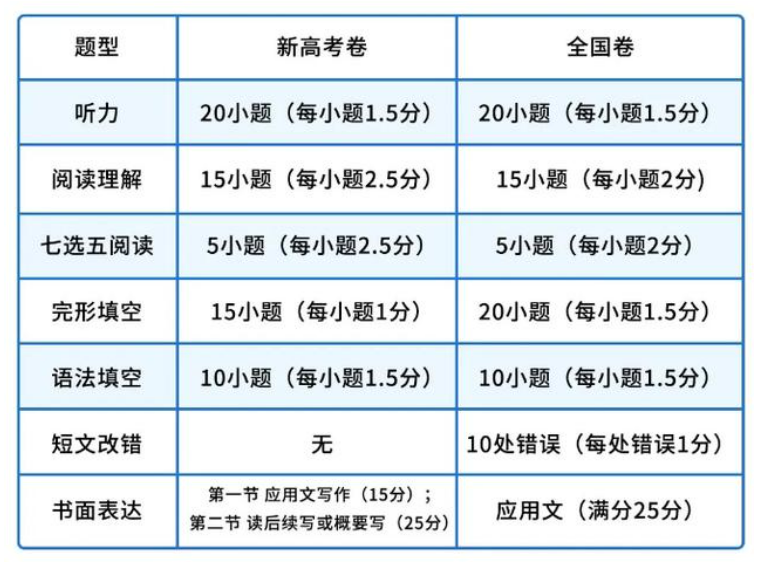
而托福考试是听说读写齐头并进的。
托福考试满分120分,由四部分组成,分别是阅读、听力、口语和写作。尽管题量和考试时长不尽相同,但是每部分的满分都是30分。也就是说,从分数比重上来说,四方面能力是同等重要的。
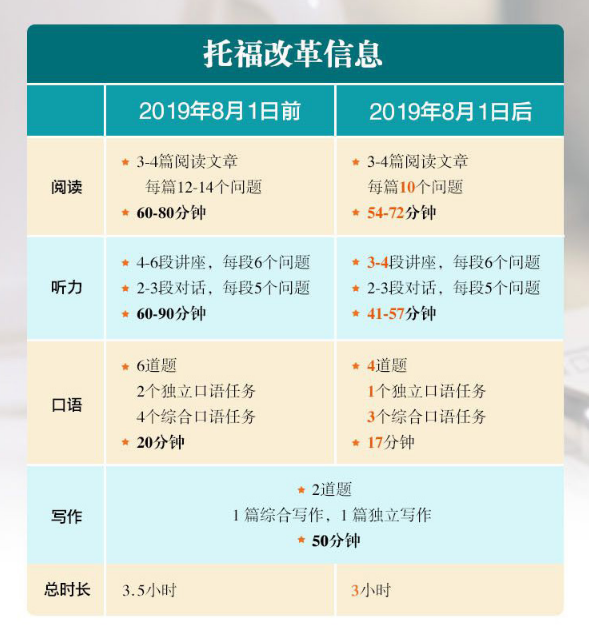
2019年托福考试改革前后的题量和时长对比
看看实际在考些什么吧,感受会更具体。下面是一些有代表性的真题,按听说读写的顺序,咱们一起看看同是高中毕业生参加的考试,两者难度相差到底有多大。
1、听力难度差异
首先,看看高考英语的听力题。
这是今年全国乙卷的听力题。考卷里有10段音频。其中5段较短,考察的是日常对话,一问一答。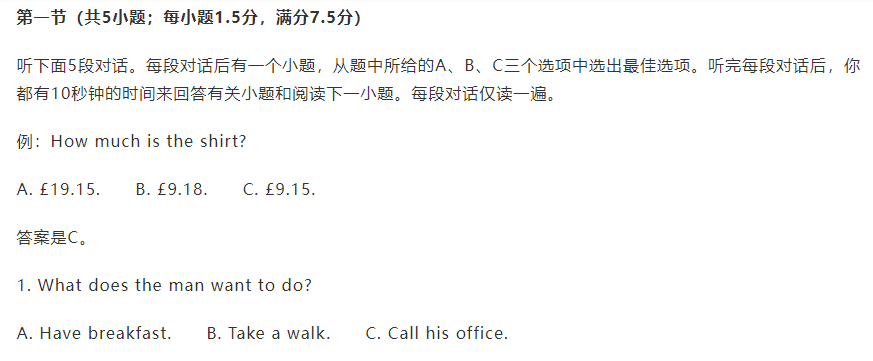
另外5段稍长的音频,听完一段材料后,要回答多个问题(关于奥运会的):

总时长近20分钟,语速较慢,每段对话或独白可以听两遍。
当然,还是看听力文本更直观。这一篇来自往年上海高考卷,在国内应该算是难度高的。学生们听完这样的材料,然后再做题。
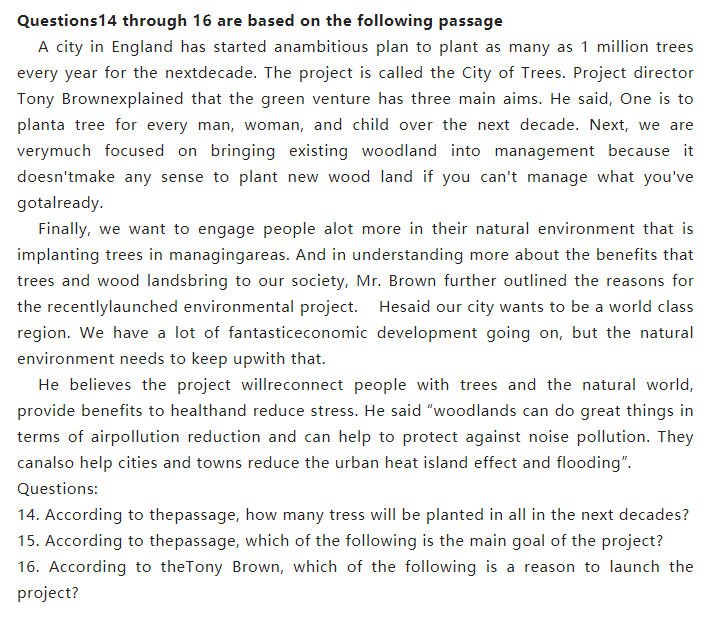
2020年上海高考英语
这段材料说的是英国一城市计划在未来十年内种植100万课树的事儿,但叙事方法、语言,感觉比较“中国化”。
A city in England has started an ambitious plan to plant as many as 1 million trees every year for the next decade. The project is called the City of Trees. Project director Tony Brown explained that the green venture has three main aims. He said, "One is to plant a tree for every man, woman, and child over the next decade. Next, we are very much focused on bringing existing wood land into management because it doesn't make any sense to plant new wood land if you can't manage what you've got already."...
再来看看托福考试的听力题。
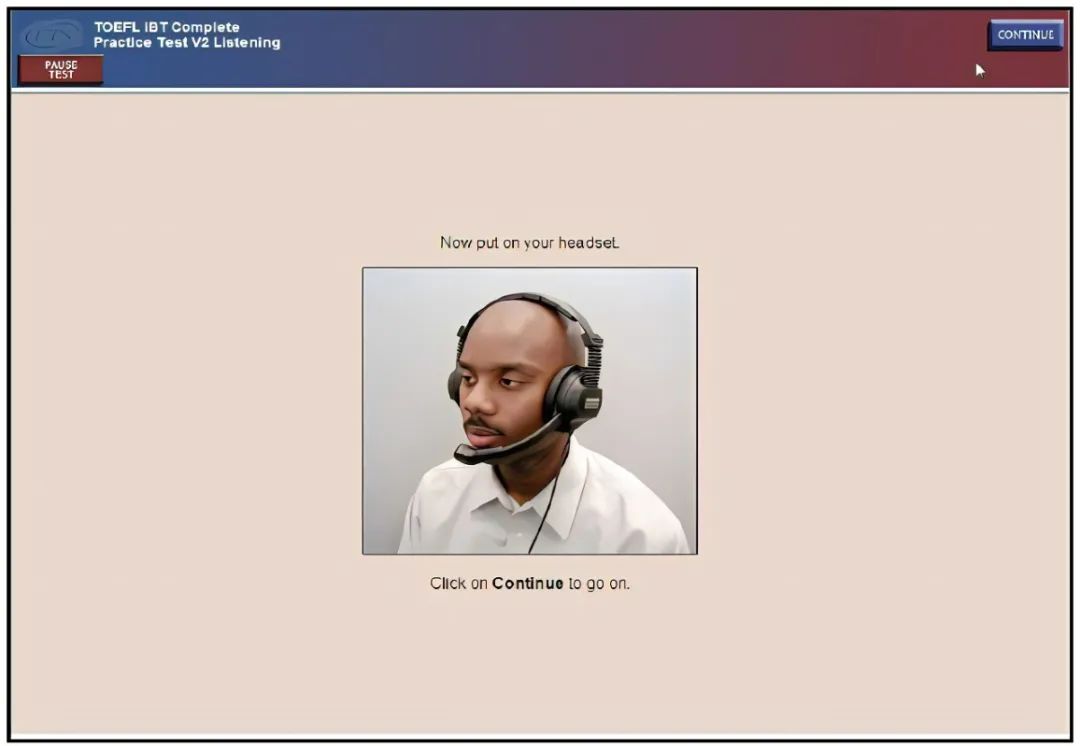
听力材料里也有对话(conversation),比如这段,给大家看看对应的文本:
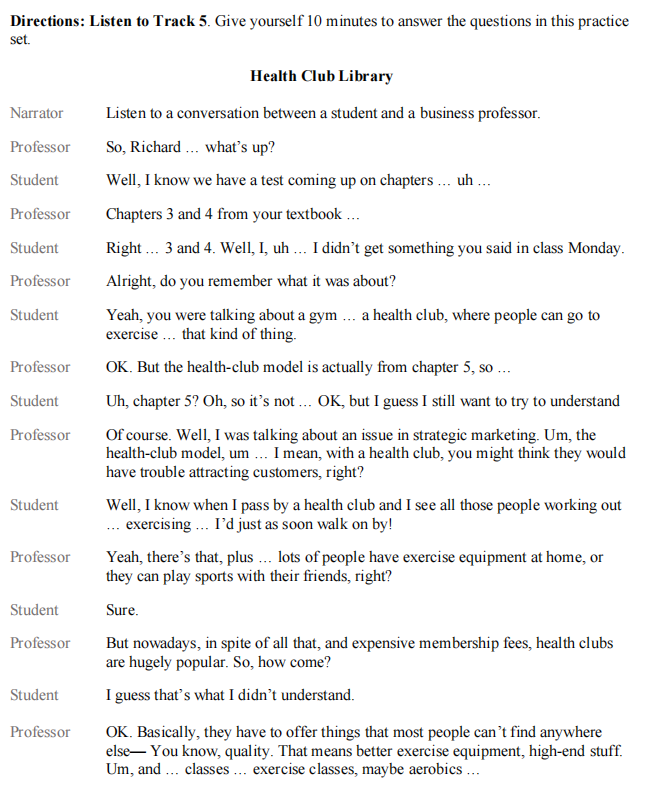
在这段对话里,学生来找教授聊自己在课上没听懂的内容。整段对话自然、流畅,和校园里随时会发生的真实对话一样,说话人会停顿、语焉不详,还会有口误:
Narrator:Listen to a conversation between a student and a business professor.
Professor So, Richard … what’s up?Student Well, I know we have a test coming up on chapters … uh …Professor Chapters 3 and 4 from your textbook …Student Right … 3 and 4. Well, I, uh … I didn’t get something you said in class Monday.Professor Alright, do you remember what it was about?Student Yeah, you were talking about a gym … a health club, where people can go to exercise … that kind of thing.Professor OK. But the health-club model is actually from chapter 5, so …
这就是我们经常说的要听懂“真实英语”(real life English)。比起传统教科书里一板一眼的对话,这种听力材料显然难多了。
还有一类听力材料是讲座(lecture),涉及到大学里的各种科目,因此,不掌握足够的学术词汇是很难过关的!
比如,下面这个讲座片段就是来自一位地质学(geology)教授:
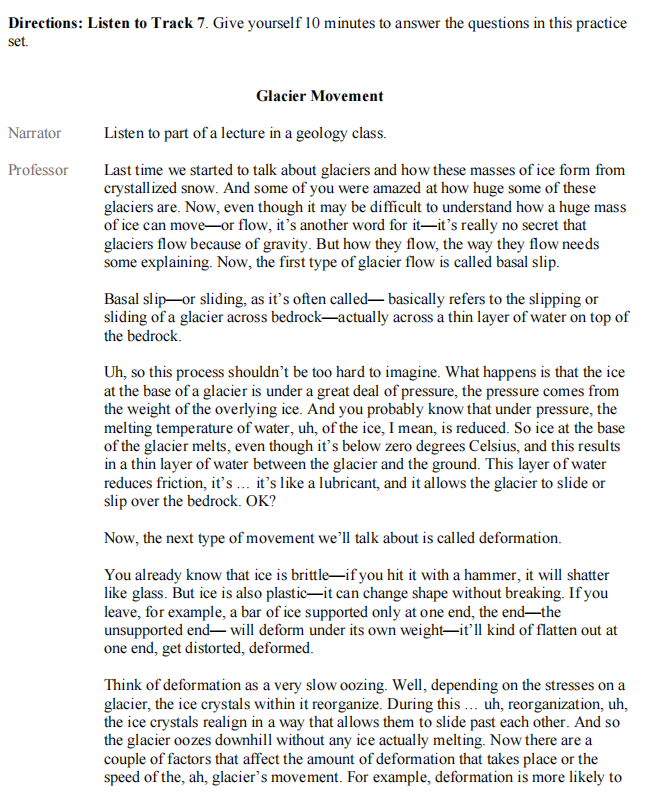
文本摆在这儿,读起来都困难,要在考场上边听边回答问题,挑战更大了。
Last time we started to talk about glaciers and how these masses of ice form from crystallized snow. And some of you were amazed at how huge some of these glaciers are. Now, even though it may be difficult to understand how a huge mass of ice can move—or flow, it’s another word for it—it’s really no secret that glaciers flow because of gravity. But how they flow, the way they flow needs some explaining. Now, the first type of glacier flow is called basal slip....
两者对比,是不是感觉听力难度,不在一个段位上?
2、口语难度差异
首先,看看高考英语的口语题。
第一部分,朗读文章,考察发音...
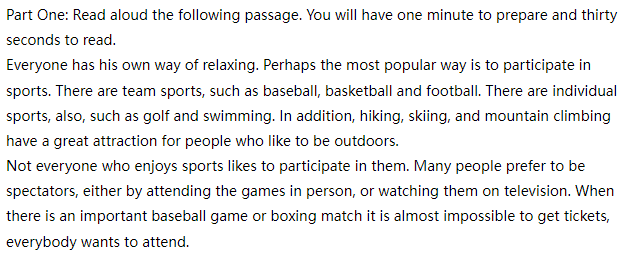
第二部分,根据听到的一句话,做出快速回应。

句子都比较简单,比如问好、道歉等,简单的日常会话...
How are things with you? I must apologize for my behavior yesterday....
第三部分,是要求学生根据情境提出两个问题。

比如,朋友邀请你一起去看演唱会,你有什么想问他的呢?
One of your friends asks you to go to a concert with him. Ask him two questions about the concert....
也就是说,在整个口语考试里,咱们的学生只要开口说几句日常会话就可以了。
再来看看托福考试的口语题。
虽然不是和真人面对面对话,但是托福考试的口语题也是出了名的难。
比如,就一件事情询问你的观点,请说说看 “你认为爱冒险尝试新事物好,还是保守点规避风险好呢”:
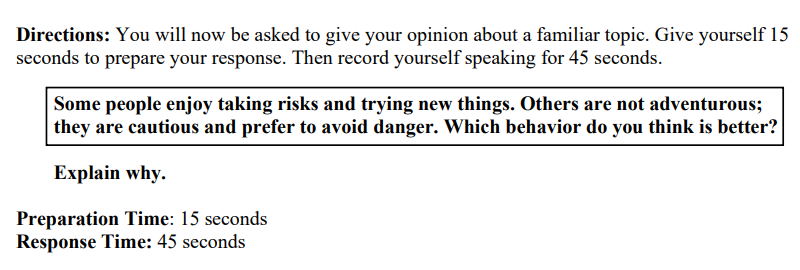
观点每个人都可以有,但考生需要给出具体的理由和例证,否则很难说服别人,比如你的教授...
准备时间15秒,然后,你要说满45秒的时间... 大概要说多少个字呢,这是一篇范文,感受一下:
I agree with the idea that children should be given homework on a daily basis.
First, homework helps children to remember their lessons for a much longer period of time. The only real way for young people to absorb a lesson is to actually go home and repeat it as much as possible. In the long run this leads to a lot more academic success.
Secondly, working together on school assignments gives children and parents a great opportunity to bond. For example, I got a lot of daily homework when I was in elementary school. Every evening I went home and worked on it with my mom and dad, and I asked them questions whenever I had trouble. As a result, we became really close.
125个字,一句话表明观点,然后是理由一、理由二...
范文照着读下来都要花些时间,更何况是要口头说出来,没有平时大量的练习是很难做到的!
还有些题目要求考生先听一段对话,比如下面这段,一个男学生和一个女学生的对话:
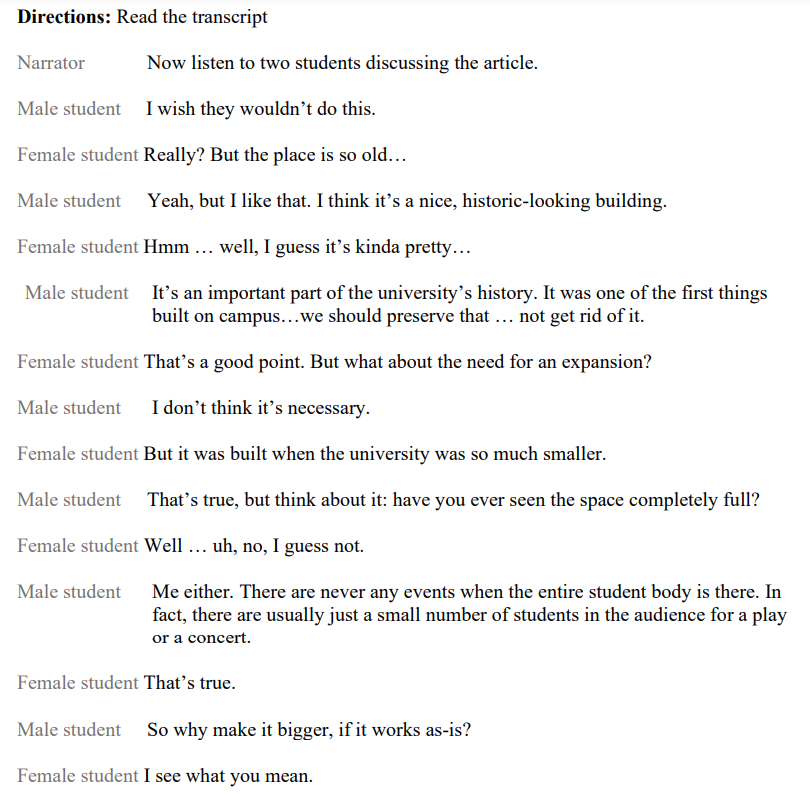
然后,对这位男学生的观点和理由,进行总结说明。
准备时间30秒,60秒说完...

难怪都说口语考试是整个托福考试中最让考生头疼的一块,因为这不是会话,不是聊天,而是口头作文啊!
和高考英语的口语部分,不是一回事。
3、阅读难度差异
首先,看看高考英语的阅读题。
高考英语中,阅读能力测试是重点。一般来说,总分150分里,阅读理解占45分。
近年来,高考英语试卷里多篇阅读文章来自外刊,难度不低,不少文章的蓝思值甚至都超过了1000L!
什么概念呢?咱来对照看看美国本土学校各个年级学生应该达到的蓝思值:
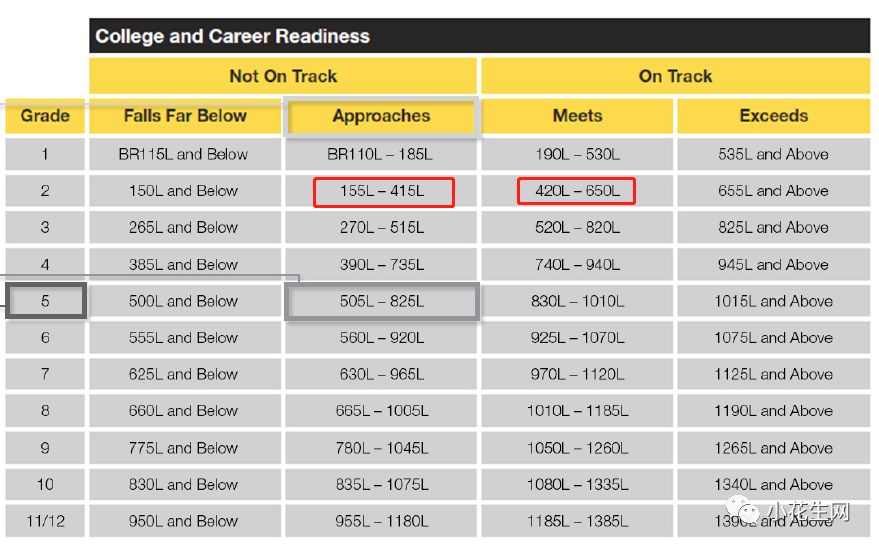
从中可以看出,蓝思值1000L大约是美国孩子7年级以上应该达到的阅读水平,相当于国内初中一年级。
比如,下面这篇关于race walking(竞走)的文章,蓝思值就在1200-1300L之间:
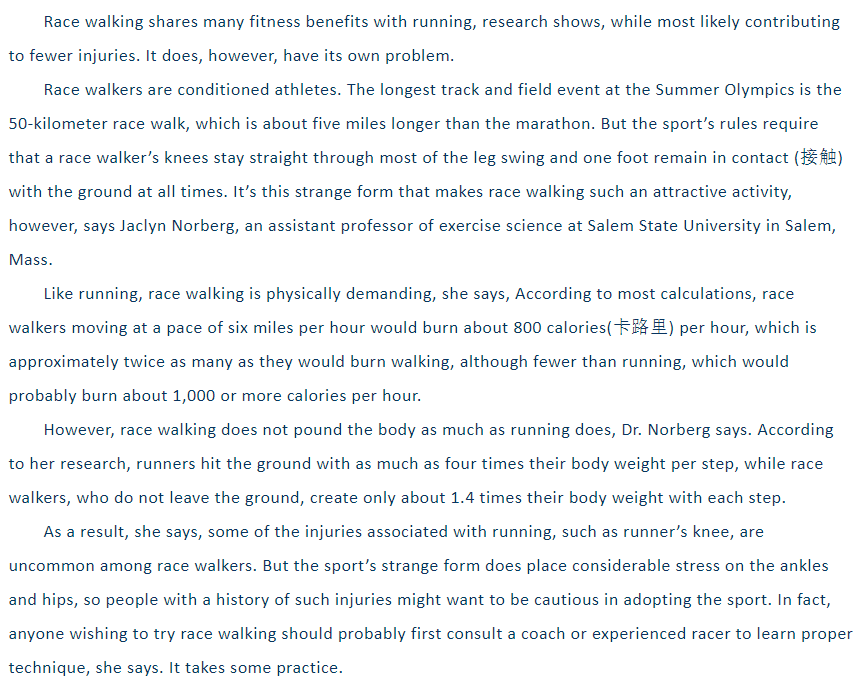
2020年高考英语全国 I 卷
通篇321个字,学术词汇不多,句型略微复杂,但单句并不算长:
【以上全文】Race walking shares many fitness benefits with running, research shows, while most likely contributing to fewer injuries. It does, however, have its own problem.
Race walkers are conditioned athletes. The longest track and field event at the Summer Olympics is the 50-kilometer race walk, which is about five miles longer than the marathon. But the sport’s rules require that a race walker’s knees stay straight through most of the leg swing and one foot remain in contact (接触) with the ground at all times. It’s this strange form that makes race walking such an attractive activity, however, says Jaclyn Norberg, an assistant professor of exercise science at Salem State University in Salem, Mass.
Like running, race walking is physically demanding, she says, According to most calculations, race walkers moving at a pace of six miles per hour would burn about 800 calories(卡路里) per hour, which is approximately twice as many as they would burn walking, although fewer than running, which would probably burn about 1,000 or more calories per hour.
However, race walking does not pound the body as much as running does, Dr. Norberg says. According to her research, runners hit the ground with as much as four times their body weight per step, while race walkers, who do not leave the ground, create only about 1.4 times their body weight with each step.
As a result, she says, some of the injuries associated with running, such as runner’s knee, are uncommon among race walkers. But the sport’s strange form does place considerable stress on the ankles and hips, so people with a history of such injuries might want to be cautious in adopting the sport. In fact, anyone wishing to try race walking should probably first consult a coach or experienced racer to learn proper technique, she says. It takes some practice.
阅读难度虽然不低,但篇幅不长,学生只需回答4个问题,包括段落意思、作者观点等:
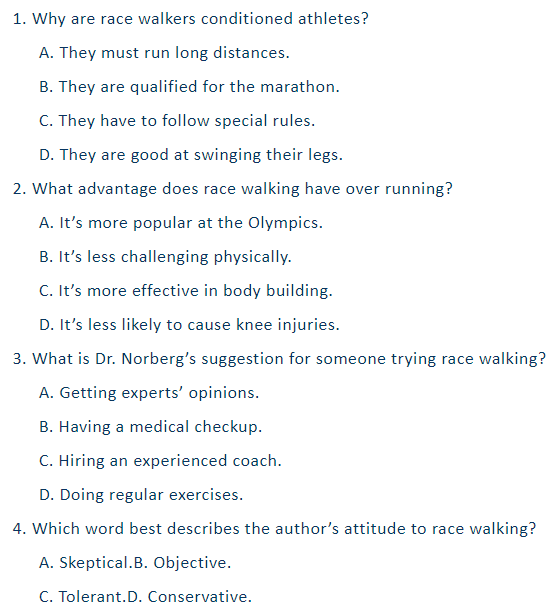
2020年高考英语全国 I 卷
再来看看托福考试的阅读题。
这一篇是普通长度,在电脑上也是密密麻麻一大片,为了截屏,我得把字体调到很小才行:

全文685个字,介绍了墨西哥一座知名古城,专业词汇多到数不过来,一眼望过去都是希腊、罗马词根词缀,而且,基本上没有短句,基本配置都是几十个单词:
【以上全文】The Rise of Teotihuacán
The city of Teotihuacán, which lay about 50 kilometers northeast of modern-day Mexico City, began its growth by 200 –100 B.C. At its height, between about A.D. 150 and 700, it probably had a population of more than 125,000 people and covered at least 20 square kilometers. It had over 2,000 apartment complexes, a great market, a large number of industrial workshops, an administrative center, a number of massive religious edifices, and a regular grid pattern of streets and buildings. Clearly, much planning and central control were involved in the expansion and ordering of this great metropolis. Moreover, the city had economic and perhaps religious contacts with most parts of Mesoamerica (modern Central America and Mexico).
How did this tremendous development take place, and why did it happen in the Teotihuacán Valley? Among the main factors are Teotihuacán's geographic location on a natural trade route to the south and east of the Valley of Mexico, the obsidian¹ resources in the Teotihuacán Valley itself, and the valley's potential for extensive irrigation. The exact role of other factors is much more difficult to pinpoint — for instance, Teotihuacán's religious significance as a shrine, the historical situation in and around the Valley of Mexico toward the end of the first millennium B.C., the ingenuity and foresightedness of Teotihuacán's elite, and, finally, the impact of natural disasters, such as the volcanic eruptions of the late first millennium B.C.
This last factor is at least circumstantially implicated in Teotihuacán's rise. Prior to 200 B.C., a number of relatively small centers coexisted in and near the Valley of Mexico. Around this time, the largest of these centers, Cuicuilco, was seriously affected by a volcanic eruption, with much of its agricultural land covered by lava. With Cuicuilco eliminated as a potential rival, any one of a number of relatively modest towns might have emerged as a leading economic and political power in Central Mexico. The archaeological evidence clearly indicates, though, that Teotihuacán was the center that did arise as the predominant force in the area by the first century A.D.
It seems likely that Teotihuacán's natural resources—along with the city elite's ability to recognize their potential — gave the city a competitive edge over its neighbors. The valley, like many other places in Mexican and Guatemalan highlands, was rich in obsidian. The hard volcanic stone was a resource that had been in great demand for many years, at least since the rise of the Olmecs (a people who flourished between 1200 and 400 B.C.), and it apparently had a secure market. Moreover, recent research on obsidian tools found at Olmec sites has shown that some of the obsidian obtained by the Olmecs originated near Teotihuacán. Teotihuacán obsidian must have been recognized as a valuable commodity for many centuries before the great city arose.
Long-distance trade in obsidian probably gave the elite residents of Teotihuacán access to a wide variety of exotic goods, as well as a relatively prosperous life. Such success may have attracted immigrants to Teotihuacán. In addition, Teotihuacán's elite may have consciously attempted to attract new inhabitants. It is also probable that as early as 200 B.C. Teotihuacán may have achieved some religious significance and its shrine (or shrines) may have served as an additional population magnet. Finally, the growing population was probably fed by increasing the number and size of irrigated fields.
The picture of Teotihuacán that emerges is a classic picture of positive feedback among obsidian mining and working, trade, population growth, irrigation, and religious tourism. The thriving obsidian operation, for example, would necessitate more miners, additional manufacturers of obsidian tools, and additional traders to carry the goods to new markets. All this led to increased wealth, which in turn would attract more immigrants to Teotihuacán. The growing power of the elite, who controlled the economy, would give them the means to physically coerce people to move to Teotihuacán and serve as additions to the labor force. More irrigation works would have to be built to feed the growing population, and this resulted in more power and wealth for the elite.
文章这么长,可以考察很多点,足足有10道题:
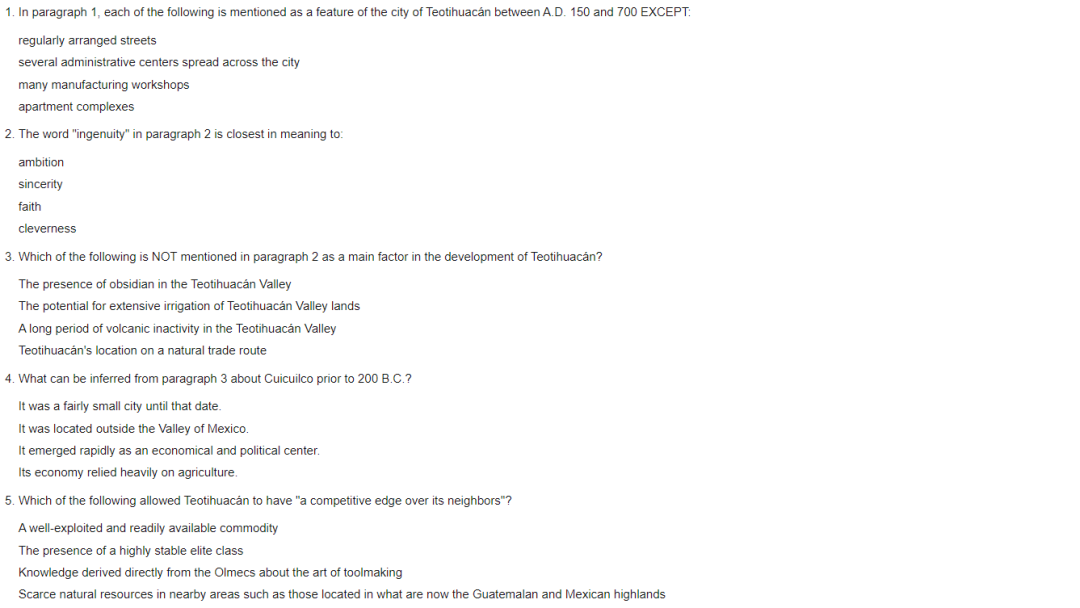
部分题目
语言知识点、细节、修辞、观点等等,总之,考察阅读理解的各个方面。
【题目摘录】In paragraph 1, each of the following is mentioned as a feature of the city of Teotihuacán between A.D. 150 and 700 EXCEPT:
The word "ingenuity" in paragraph 2 is closest in meaning to:
Which of the following is NOT mentioned in paragraph 2 as a main factor in the development of Teotihuacán?
What can be inferred from paragraph 3 about Cuicuilco prior to 200 B.C.?
Which of the following allowed Teotihuacán to have "a competitive edge over its neighbors"?
According to paragraph 4, what has recent research on obsidian tools found at Olmecsites shown?
Select the TWO answer choices that are mentioned in paragraph 5 as being features of Teotihuacán that may have attracted immigrants to the city. To receive credit, you must select TWO answers.
In paragraph 6, the author discusses "The thriving obsidian operation," in order to:
...
有人对托福阅读考试做了蓝思值测试,发现绝大部分文章的蓝思值在1200L至1500L之间。
这么看来,从蓝思值来说,高考英语和托福文章的阅读难度差距并不算很大。不过由于托福文章学术性更强、篇幅更长、题目更难,因此难度上还是比高考高出很多。
4、写作难度差异
先来看看高考英语的写作题。
短文改错,题目要求是用中文写的,要修改的文章比高考英语阅读部分的文章简单很多:

2022年高考英语全国甲卷
书面表达,也就是写作题,要求学生围绕一个主题,写出100字左右的短文:

2022年高考英语全国甲卷
这是一篇范文。学生只要用比较基础的单词和句型,把意思表达清楚就可以了。
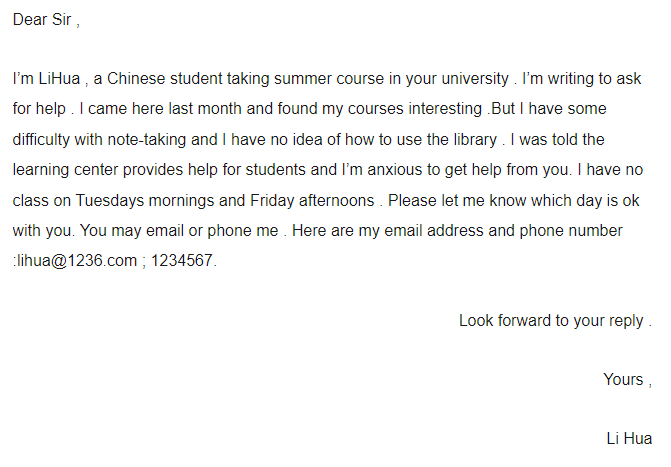
再来看看托福考试的写作题。
和托福口语考试类似,要求考生先看一篇文章,或是先听一段话,或者,就是根据一个问题,来表明观点、罗列证据:
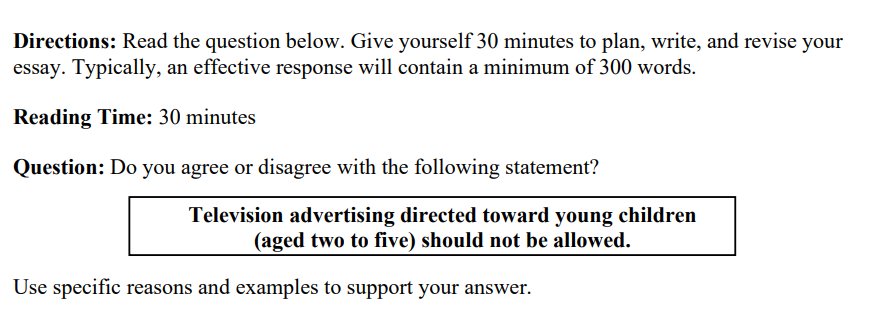
虽然是孩子们从初中就开始写的议论文,但要在二三十分钟的时间内,写出下面这样一篇三四百字、有理有据的学术性文章,挑战还是很大的:

可以看出,高考英语考的是基本英语书面表达能力,而托福更加侧重考察学术写作能力,毕竟进入大学后学生需要完成各种各样的essays ...
4高中毕业前如何达到“理想水平”?
做了这么多对比,现在可以回答文章开头的这个问题了:小学都没毕业的孩子,做英语高考题为何能轻松拿高分、甚至满分?是孩子太牛,还是考试太容易?

7岁男孩昊昊全国I卷125分里得了101.5分,浙江卷110分里得了87分(不含作文)。花友@榴妈 的二年级女儿也用全国I卷自测,除作文外,得102分。
答案应该是,两个因素都有:对学的得法的孩子(号称“原版娃”,他们的英语学习效率与水平,和同龄孩子相比,遥遥领先。)高考英语确实不难。
事实上,每个“原版娃”都是“英语牛娃”。这条路线上的成功案例,有很多 …
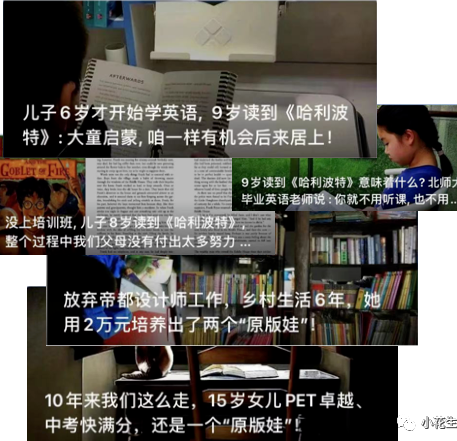
这样的孩子,小花生App社区里有成千上万。总结他们的实际学习案例,可以总结出这样一张“原版娃英语学习路径图”。
简单来说,从4-5岁启蒙到英语完全过关(听说读写自由,交流表达无障碍,词汇量过万,可以在全英语环境下学习),大概10年左右时间,这比我们当年花16年(12年中小学+4年大学)学成“哑巴英语”要强太多!
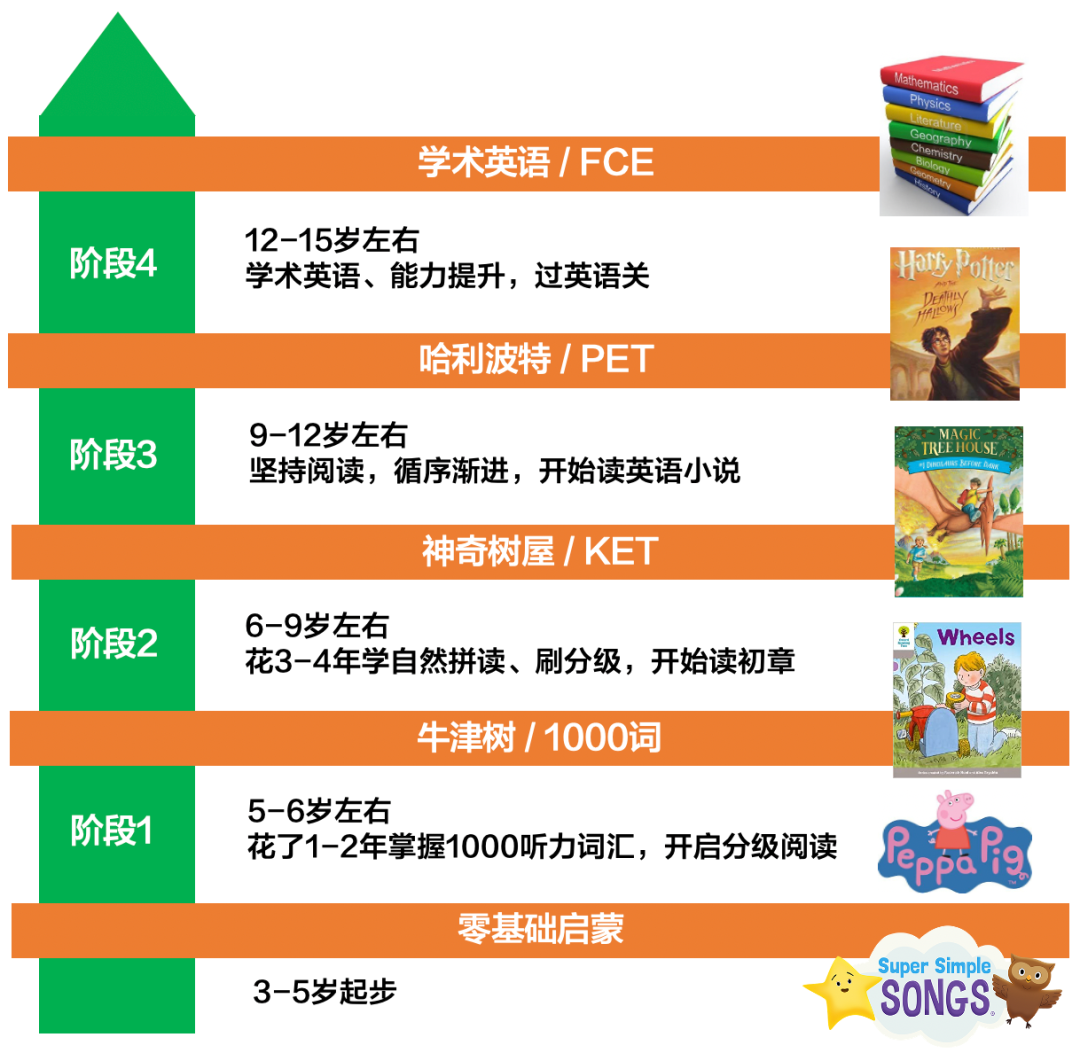
对于这些孩子,高中毕业前的英语水平,尤其在听力、阅读上,是可以直接追平母语孩子的,托福考试不在话下,如果有留学打算,考SAT, ACT等美国本土大学考试,也会比较顺利。
如果孩子在高中毕业之际,能够获得这样的英语能力,或者能达到基本通过托福考试的水平,则无论留不留学,都会是一个比较理想的境地。正如@youyou西木成林所说:
“到了这个水平和年级,学英语已经不是我们的主要目标了,如何用英语看向世界、助力学科学习,才是我们这个阶段的重点。”
的确,让孩子花这么多时间学英语,目的不就是“和世界对接么?”
而仅仅在高考中拿个好成绩,不光是不够用,也对不起这么多年的时间付出啊~是时候反思咱们的英语学习目标、学习方式了。
推荐阅读
- 托福攻略:科学备考方法与实战技巧全解析
- 托福考试:这些高效备考技巧让你少走弯路!
- 攻克托福阅读三大难题:否定事实信息题、推断题和小结题深度解析
- 托福高分秘籍:不只是埋头苦学,这些技巧让你事半功倍!
- 托福考试全方位突破指南:从基础到高分的系统化策略
- 托福高分秘籍:告别无效刷题,这些技巧让你轻松突破100+
- 托福听力6大黄金技巧:告别低效刷题,轻松突破28+!
【本文标签】:
【责任编辑】:常州新航道小编 版权所有:转载请注明出处
